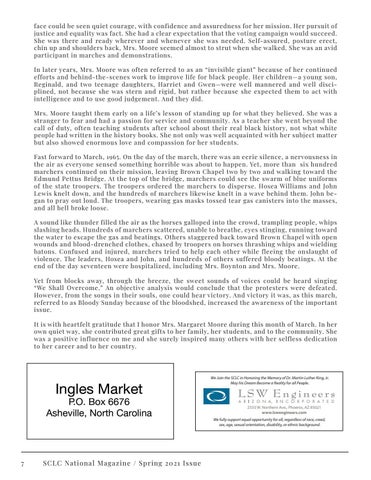face could be seen quiet courage, with confidence and assuredness for her mission. Her pursuit of justice and equality was fact. She had a clear expectation that the voting campaign would succeed. She was there and ready wherever and whenever she was needed. Self-assured, posture erect, chin up and shoulders back, Mrs. Moore seemed almost to strut when she walked. She was an avid participant in marches and demonstrations. In later years, Mrs. Moore was often referred to as an “invisible giant” because of her continued efforts and behind-the-scenes work to improve life for black people. Her children—a young son, Reginald, and two teenage daughters, Harriet and Gwen—were well mannered and well disciplined, not because she was stern and rigid, but rather because she expected them to act with intelligence and to use good judgement. And they did. Mrs. Moore taught them early on a life’s lesson of standing up for what they believed. She was a stranger to fear and had a passion for service and community. As a teacher she went beyond the call of duty, often teaching students after school about their real black history, not what white people had written in the history books. She not only was well acquainted with her subject matter but also showed enormous love and compassion for her students. Fast forward to March, 1965. On the day of the march, there was an eerie silence, a nervousness in the air as everyone sensed something horrible was about to happen. Yet, more than six hundred marchers continued on their mission, leaving Brown Chapel two by two and walking toward the Edmund Pettus Bridge. At the top of the bridge, marchers could see the swarm of blue uniforms of the state troopers. The troopers ordered the marchers to disperse. Hosea Williams and John Lewis knelt down, and the hundreds of marchers likewise knelt in a wave behind them. John began to pray out loud. The troopers, wearing gas masks tossed tear gas canisters into the masses, and all hell broke loose. A sound like thunder filled the air as the horses galloped into the crowd, trampling people, whips slashing heads. Hundreds of marchers scattered, unable to breathe, eyes stinging, running toward the water to escape the gas and beatings. Others staggered back toward Brown Chapel with open wounds and blood-drenched clothes, chased by troopers on horses thrashing whips and wielding batons. Confused and injured, marchers tried to help each other while fleeing the onslaught of violence. The leaders, Hosea and John, and hundreds of others suffered bloody beatings. At the end of the day seventeen were hospitalized, including Mrs. Boynton and Mrs. Moore. Yet from blocks away, through the breeze, the sweet sounds of voices could be heard singing “We Shall Overcome.” An objective analysis would conclude that the protesters were defeated. However, from the songs in their souls, one could hear victory. And victory it was, as this march, referred to as Bloody Sunday because of the bloodshed, increased the awareness of the important issue. It is with heartfelt gratitude that I honor Mrs. Margaret Moore during this month of March. In her own quiet way, she contributed great gifts to her family, her students, and to the community. She was a positive influence on me and she surely inspired many others with her selfless dedication to her career and to her country.
We Join the SCLC in Honoring the Memory of Dr. Martin Luther King, Jr. May his Dream Become a Reality for all People.
2333 W. Northern Ave., Phoenix, AZ 85021 www.lswengineers.com We fully support equal opportunity for all, regardless of race, creed, sex, age, sexual orientation, disability, or ethnic background.
7
S C LC Na tional Magaz ine / Spring 2 02 1 Is s ue











